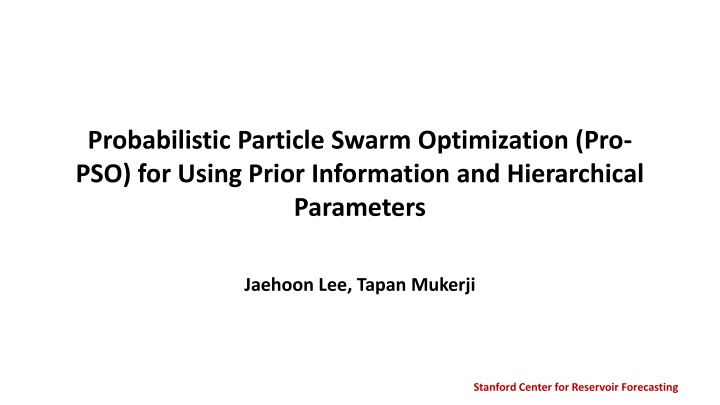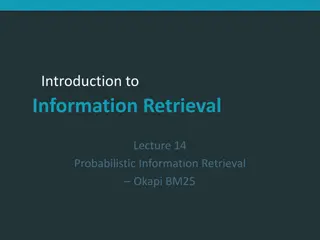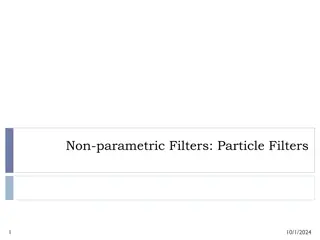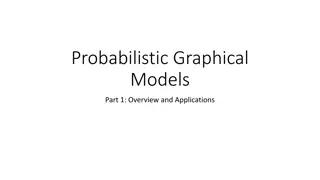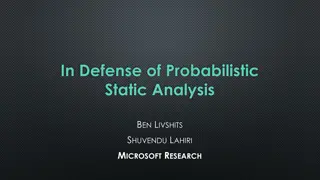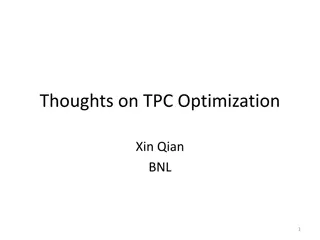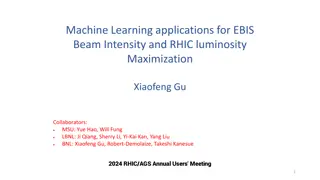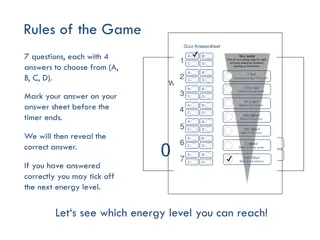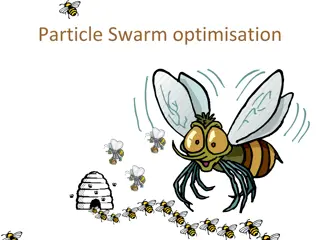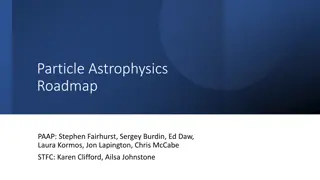Probabilistic Particle Swarm Optimization for Using Prior Information
In this study by Jaehoon Lee and Tapan Mukerji from Stanford Center for Reservoir Forecasting, they introduce Pro-PSO, a technique that leverages prior knowledge and hierarchical parameters to enhance optimization processes. The method combines the strengths of particle swarm optimization with probabilistic approaches, resulting in improved forecasting accuracy and efficiency in reservoir management. By integrating prior information effectively, Pro-PSO offers a promising solution for optimizing complex systems in various domains.
Download Presentation

Please find below an Image/Link to download the presentation.
The content on the website is provided AS IS for your information and personal use only. It may not be sold, licensed, or shared on other websites without obtaining consent from the author.If you encounter any issues during the download, it is possible that the publisher has removed the file from their server.
You are allowed to download the files provided on this website for personal or commercial use, subject to the condition that they are used lawfully. All files are the property of their respective owners.
The content on the website is provided AS IS for your information and personal use only. It may not be sold, licensed, or shared on other websites without obtaining consent from the author.
E N D
Presentation Transcript
Probabilistic Particle Swarm Optimization (Pro- PSO) for Using Prior Information and Hierarchical Parameters Jaehoon Lee, Tapan Mukerji Stanford Center for Reservoir Forecasting
What Is Particle Swarm Optimization (PSO)? Individual Learning Pros Simple and easy to be hybridized Global optimizer with multiple solutions Favorable for parallel computing Faster than other evolutionary methods Cons Computational cost No easy way to use probabilistic prior information Solution Neighborhood s Learning Stanford Center for Reservoir Forecasting
Objective of Probabilistic PSO (Pro-PSO) How to incorporate a probabilistic form of prior information into PSO PSO Probabilistic Prior More Probable Particles Solution Stanford Center for Reservoir Forecasting
Incorporating Prior Probabilities Prior Probability Conditional probability given prior data dprior: P(x|dprior) Prior PSO Algorithm probability PSO Newtonian physics : Perturbation of candidate solutions Movement of particles algorithm What is the probabilistic form of PSO? Stanford Center for Reservoir Forecasting
General PSO Algorithm xi(t+1) : position of particle i at iteration t+1: ( ) ( ) t + = + + = i x x v 1 ( 1) , 1,2,..., t t t S i i i Personal best position of particle i vi(t+1) : velocity of particle i at iteration t+1: ( ) ( ) t ( ) t ( ) t ( ) t + = + + t = i v v R p x R g x 1 ( ) t , 1,2,..., t w a a t S i i p p i i g g i S : total population of the swarm where Global best position w : inertia constant , a R a : personal and global acceleration constants R: diagonal matrices with random numbers from uniform distribution U[0,1] p g , p g Stanford Center for Reservoir Forecasting
Derivation of Pro-PSO Total number of parameters = N k axis Particle i wvik(t) Personal attractor, pik(t) Global Current position, xik(t) attractor, gk(t) Acceleration ( ) ( ) t ( ) t ( ) t ( ) t ( ) t + = + + + k i k i k i k i k i k k i 1 ( ) x t x wv t a r p x a r g x p p g g = i = k 1,2,..., , 1,2,..., S N Sampling of perturbation ( ) ( ) ( ) ( ) t ( ) t ( ) t ( ) t ( ) t + = + + + k i k i k i k i k i k k i 1 ( ) ,0 0, x t x wv t U a p x U a g x p g 6 Stanford Center for Reservoir Forecasting
Derivation of Pro-PSO PSO ( ) ( ) ( ) ( ) t ( ) t ( ) t ( ) t ( ) t + = + + + k i k i k i k i k i k k i 1 ( ) ,0 0, x t x wv t U a p x U a g x p g ( ) ( ) t + = + + + k i k i k i k k 1 ( ) , , x t x wv t U u u U u u ( ) i p ( ) ( ) ( ) i g ( ) ( ) p min p max g min g max Convolution u ( )( ) i g ( )( i p ) ( )( ) i g ( ) = k k p max P z U z y U y dy Pro-PSO k k * U U u ( ) i p ( ) p min ( ) ( ) ( ) ( ) t ( ) t ( ) t ( ) ( ) t + = + k i k i k i k i k k i k i k i 1 , ( ), , 1 ( ) P x t x v t p g P x t x wv t k k * U U ( ) i p ( ) i g ( ) u ( ) ( ) t ( )( ) i p ( ) = + k k i k i k i k p max 1 ( ) , = i = k U x t x wv t y U y dy 1,2,..., , 1,2,..., S N ( ) i g u ( ) p min Stanford Center for Reservoir Forecasting
Derivation of Pro-PSO Total number of parameters = N k axis Particle i wvik(t) Personal attractor, pik(t) Global Current position, xik(t) attractor, gk(t) Pro-PSO ( ) ( ) ( ) ( ) t v t p ( ) t ( ) t ( ) ( ) t + = + k i k i k i k i k k i k i k i 1 , ( ), , 1 ( ) P x t x g P x t x wv t k k * U U ( ) i p ( ) i g ( ) u ( ) ( ) t ( )( ) i p ( ) = + k k i k i k i k p max 1 ( ) , = i = k U x t x wv t y U y dy 1,2,..., , 1,2,..., S N ( ) i g u ( ) p min 8 Stanford Center for Reservoir Forecasting
Incorporating Prior Probabilities Combined probability Prior Probability PSO Conditional probability given prior data dprior: P(x|dprior) probability Prior PSO Probability probability Conditional probability given the vectors at iteration t: P(xi(t+1)|xi(t), vi(t), pi(t), g(t)) Combined Probability P(xi(t+1)|xi(t), vi(t), pi(t), g(t), dprior) Tau Model (Journel, 2002) xi(t) = 0, pi(t) = 5, g(t) =7 Stanford Center for Reservoir Forecasting
Comparison of Pro-PSO and PSO 2D Synthetic Reservoir Seismic Inversion Flow History Matching Acoustic Impedance Production Rates Stanford Center for Reservoir Forecasting
Comparison of Pro-PSO and PSO 2D Synthetic Reservoir Principal Component Analysis(PCA) 90% variation : 300 PCs 2501 realizations Fern ndez-Mart nez et al. (2010), Suman (2013), and Sarma (2006) Stanford Center for Reservoir Forecasting
Prior Probabilities from Realizations Pro-PSO can utilize the distributions In PSO, particles move within the boundaries Stanford Center for Reservoir Forecasting
Pro-PSO and PSO: Search Space Projected 300-dimensional Search Space : each vertical line represents one axis In PSO, particles move within the boundaries Stanford Center for Reservoir Forecasting
Pro-PSO and PSO: Search Space Projected 300-dimensional Search Space The score distributions are incorporated into Pro-PSO Stanford Center for Reservoir Forecasting
Pro-PSO and PSO: Performance (Seismic) Misfit = 0.7312 Misfit = 0.2181 Pro-PSO accomplished the minimum misfit of PSO after 12 iterations Stanford Center for Reservoir Forecasting
Pro-PSO and PSO: Best Models Reference with 300 PCs Pro-PSO PSO Stanford Center for Reservoir Forecasting
Pro-PSO and PSO: Variogram Major Direction (45 ) Minor Direction (135 ) Stanford Center for Reservoir Forecasting
Pro-PSO and PSO: Performance (Flow) Pro-PSO accomplished the minimum misfit of PSO after 24 iterations Misfit = 0.00220 Misfit = 0.00068 Stanford Center for Reservoir Forecasting
Pro-PSO and PSO: Production Rates Pro-PSO PSO Stanford Center for Reservoir Forecasting
Pro-PSO with Hierarchical Use of Parameters Pro-PSO runs on only part of parameters first and then includes the rest of the parameters hierarchically. Hierarchy 2 Hierarchy 1 - PSO with part of parameters, k= 1, , h1 - Global and personal best positions : pki(h1), gk(h1) for i= 1, , S and k= 1, , h1 - Add the next part of parameters, k= 1, , h1, , h2 - Prior probability : P(xki(h2)|pki(h1), gk(h1)) or P(xki(h2)|gk(h1)) for i= 1, , S and k= 1, , h1 Stanford Center for Reservoir Forecasting
Pro-PSO and PSO: Performance (Seismic) Pro-PSO uses the first 22 PCs (50% variance) and the 278 PCs are added when the best 50 models fall within the 80% of the search space. Misfit = 0.7312 Misfit = 0.5301 Stanford Center for Reservoir Forecasting
Pro-PSO and PSO: Best Models Reference with 300 PCs Pro-PSO w/ Hierarchies PSO Stanford Center for Reservoir Forecasting
Pro-PSO and PSO: Variogram Major Direction (45 ) Minor Direction (135 ) Stanford Center for Reservoir Forecasting
Conclusions and Future Work Reformulated PSO from a probabilistic point of view. Allows incorporating probabilistic prior information. Investigated the possibility of the hierarchical use of parameters. Analyze the performance and stability of PSO. Can be a pseudo-sampler. Stanford Center for Reservoir Forecasting
